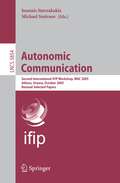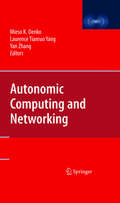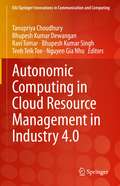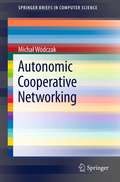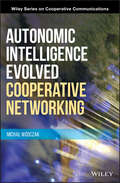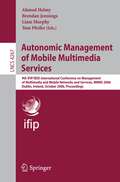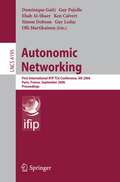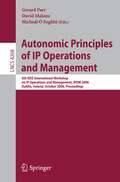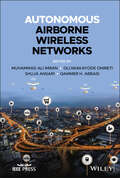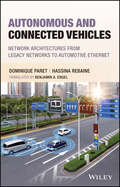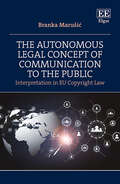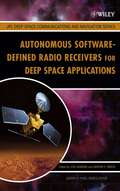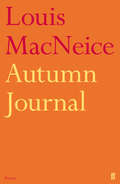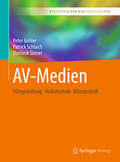- Table View
- List View
Automatisierung im schienengebundenen Nahverkehr: Funktionen und Nutzen von Communication-Based Train Control (CBTC) (essentials)
by Lars SchniederInnerstädtische Schienenverkehrssysteme stoßen bei steigender Verkehrsnachfrage zunehmend an ihre Grenzen. Die Sicherheit und die Leistungsfähigkeit dieser Verkehrssysteme werden wesentlich durch die eingesetzte Leit- und Sicherungstechnik bestimmt. Eine Ausweitung des Verkehrsangebots erfordert leistungsfähige signaltechnische Systeme, die als Communications-Based Train Control (CBTC) bezeichnet werden. Lars Schnieder stellt in diesem essential die Systemumgebung dar, in die sich die CBTC-Systeme in Nahverkehrsunternehmen integrieren. Darüber hinaus leitet er her, welchen Beitrag die einzelnen Sicherungsfunktionen von CBTC-Lösungen zur Gefährdungsbeherrschung leisten. Auf dieser Grundlage zeigt der Autor, wie mit zunehmender Automatisierung sukzessive ein höherer Funktionsumfang von technischen Systemen übernommen wird. Zum Abschluss diskutiert er an CBTC-Systeme gestellte nicht-funktionale Anforderungen wie Sicherheit, Verfügbarkeit, Leistungsfähigkeit und Wirtschaftlichkeit.Der Autor: Dr.-Ing. Lars Schnieder verantwortet in einer Software-Entwicklungsfirma das Geschäftsfeld Sicherheitsbegutachtung. Er ist international als anerkannter Sachverständiger für Zugsicherungsanlagen tätig.
Automatisierungstechnik 1: Meß- und Sensortechnik (VDI-Buch)
by Hans-Jürgen GevatterFür die Probleme des planenden Ingenieurs werden die Elemente zur Lösung seiner Aufgaben genannt und in Aufbau und Funktion beschrieben. Es gibt einen Überblick über die wichtigen Grundlagen und Bauelemente und deren Eigenschaften, aus denen komplexe Systeme der Meßtechnik aufgebaut werden. Ein umfassendes Abkürzungsverzeichnis der Automatisierungstechnik rundet das Werk ab. Zum Leserkreis gehören Ingenieure aus Industrie, Planung, Entwicklung und Forschung sowie Hochschullehrer und Studenten.
Automatisierungstechnik 3: Aktoren (VDI-Buch)
by Hans-Jürgen GevatterAktoren, pneumatische Stellelemente und Relais werden in Aufbau und Funktion beschrieben. Eine Begriffserläuterung und ein umfassendes Abkürzungsverzeichnis der Automatisierungstechnik rundet das Werk ab. Zum Leserkreis gehören Studenten der Automatisierungstechnik, Ingenieure aus Industrie, Planung, Entwicklung und Forschung.
Automobile Erlebniswelten als Kommunikationsmittel: Eine verhaltenswissenschaftliche Analyse am Beispiel des Premiummarktes in Deutschland und Singapur (Europäische Kulturen in der Wirtschaftskommunikation)
by Franziska MassenbachAutomotive Internetworking (Intelligent Transport Systems #4)
by Timo Kosch Christoph Schroth Markus Strassberger Marc BechlerA complete introduction tocar-to-X communications networking Automotive Inter-networking will introduce a range of new network and system technologies for vehicle safety, entertainment and comfort systems currently being researched and developed. C2X networking is not only a matter of technology, but is also very closely related to policy-making about deployment. This book will provide the background on technical developments but will also discuss the potential benefits, costs and risks. Also discussed will be concepts related to application of vehicle-to-vehicle and vehicle-to-infrastructure communication technologies for various purposes such as automobile safety enhancement, vehicle user applications for comfort and convenience and efficiency along with other potential commercial applications. Application domains will build the starting point for an analysis of the requirements on suitable mobile network technology and the book will look at how well existing and new systems match these requirements. New automotive-specific technologies are presented in detail, explaining millimeter wave short range systems and special automotive network protocols. Specially designed system services and security mechanisms are introduced and system architecture, radio spectrum use, medium access control, network protocols and security concepts and considered. Finally, the book will present the current world-wide standardization activities, deployment strategies and an outlook about the evolvement of inter-vehicle communications in the next decades. Presents a comprehensive top-down approach to the newly evolving car-to-X communications networking Provides a broad overview of all relevant C2X communication topics Written by well known experts in the field Predicts the outlook of the evolvement of inter-vehicle communications in the next decades Includes illustrations and high-level technical sketches of application domains and photographs, 3D renderings and professional graphical sketches of current prototypes
Automotive Internetworking (Intelligent Transport Systems #3)
by Timo Kosch Christoph Schroth Markus Strassberger Marc BechlerA complete introduction tocar-to-X communications networking Automotive Inter-networking will introduce a range of new network and system technologies for vehicle safety, entertainment and comfort systems currently being researched and developed. C2X networking is not only a matter of technology, but is also very closely related to policy-making about deployment. This book will provide the background on technical developments but will also discuss the potential benefits, costs and risks. Also discussed will be concepts related to application of vehicle-to-vehicle and vehicle-to-infrastructure communication technologies for various purposes such as automobile safety enhancement, vehicle user applications for comfort and convenience and efficiency along with other potential commercial applications. Application domains will build the starting point for an analysis of the requirements on suitable mobile network technology and the book will look at how well existing and new systems match these requirements. New automotive-specific technologies are presented in detail, explaining millimeter wave short range systems and special automotive network protocols. Specially designed system services and security mechanisms are introduced and system architecture, radio spectrum use, medium access control, network protocols and security concepts and considered. Finally, the book will present the current world-wide standardization activities, deployment strategies and an outlook about the evolvement of inter-vehicle communications in the next decades. Presents a comprehensive top-down approach to the newly evolving car-to-X communications networking Provides a broad overview of all relevant C2X communication topics Written by well known experts in the field Predicts the outlook of the evolvement of inter-vehicle communications in the next decades Includes illustrations and high-level technical sketches of application domains and photographs, 3D renderings and professional graphical sketches of current prototypes
Autonomic Communication (Lecture Notes In Physics #Vol. 51)
by Stamatis Karnouskos Manish Parashar Witold Pedrycz Athanasios V. VasilakosNew paradigms for communication/networking systems are needed in order to tackle the emerging issues such as heterogeneity, complexity and management of evolvable infrastructures. In order to realize such advanced systems, approaches should become task- and knowledge-driven, enabling a service-oriented, requirement, and trust-driven development of communication networks. The networking and seamless integration of concepts, technologies and devices in a dynamically changing environment poses many challenges to the research community, including interoperability, programmability, management, openness, reliability, performance, context awareness, intelligence, autonomy, security, privacy, safety, and semantics. This edited volume explores the challenges of technologies to realize the vision where devices and applications seamlessly interconnect, intelligently cooperate, and autonomously manage themselves, and as a result, the borders of virtual and real world vanish or become significantly blurred.
Autonomic Communication: First International IFIP Workshop, WAC 2004, Berlin, Germany, October 18-19, 2004, Revised Selected Papers (Lecture Notes in Computer Science #3457)
by Michael SmirnovThe ?rst IFIP Workshop on Autonomic Communication (WAC 2004) was held 18–19 October 2004 in Berlin, Germany. The workshop was organized by Fra- hofer FOKUS with the help of partners of the EU-funded Autonomic Com- nication Coordination Action — IST-6475 (ACCA), and under technical sp- sorship of IFIP WG6. 6 — Management of Networks and Distributed Systems. The purpose of this workshop was to discuss Autonomic Communication—a new communication paradigm to assist the design of the next-generation n- works. WAC 2004 was explicitly focused on the principles that help to achieve purposeful behavior on top of self-organization (self-management, self-healing, self-awareness, etc. ). The workshop intended to derive these common principles from submissions that study network element’s autonomic behavior exposed by innovative (cross-layer optimized, context-aware, and securely programmable) protocol stack (or its middleware emulations) in its interaction with numerous, often dynamic network groups and communities. The goals were to understand how autonomic behaviors are learned, in?uenced or changed, and how, in turn, these a?ect other elements, groups and the network. The highly interactive and exploratory nature of WAC 2004 de?ned its format — six main sessions grouped in three blocks, each block followed by a panel with all speakers of the previous block as panellists and session chairs as panel moderators. The?rstpanelaimedtohighlightthemainprinciplesguidingresearchinal- rithms,protocolsandmiddleware;thesecondpanelinvestigatedgrandchallenges of network and service composition; the third panel had to answer the question “HowDoestheAutonomicNetworkInteractwiththeKnowledgePlane?”. Panel reports were compiled by panel moderators and conclude this volume.
Autonomic Communication: Second International IFIP Workshop, WAC 2005, Athens, Greece, October 2-5, 2005, Revised Selected Papers (Lecture Notes in Computer Science #3854)
by Ioannis Stavrakakis Michael SmirnovThis book constitutes the thoroughly refereed post-proceedings of the Second International IFIP Workshop on Autonomic Communication, WAC 2005, held in Athens, Greece in October 2005. The 22 revised full papers presented together with one keynote paper, three invited papers and two panel summaries were carefully selected during two rounds of reviewing and improvement from numerous submissions. The papers discuss the principles of Autonomic Communication (AC).
Autonomic Computing and Networking
by Mieso Denko Laurence Tianruo Yang Yan ZhangAutonomic Computing and Networking presents introductory and advanced topics on autonomic computing and networking with emphasis on architectures, protocols, services, privacy & security, simulation and implementation testbeds. Autonomic computing and networking are new computing and networking paradigms that allow the creation of self-managing and self-controlling computing and networking environment using techniques such as distributed algorithms and context-awareness to dynamically control networking functions without human interventions. Autonomic networking is characterized by recovery from failures and malfunctions, agility to changing networking environment, self-optimization and self-awareness. The self-control and management features can help to overcome the growing complexity and heterogeneity of exiting communication networks and systems. The realization of fully autonomic heterogeneous networking introduces several research challenges in all aspects of computing and networking and related fields.
Autonomic Computing in Cloud Resource Management in Industry 4.0 (EAI/Springer Innovations in Communication and Computing)
by Tanupriya Choudhury Bhupesh Kumar Dewangan Ravi Tomar Bhupesh Kumar Singh Teoh Teik Toe Nguyen Gia NhuThis book describes the next generation of industry—Industry 4.0—and how it holds the promise of increased flexibility in manufacturing, along with automation, better quality, and improved productivity. The authors discuss how it thus enables companies to cope with the challenges of producing increasingly individualized products with a short lead-time to market and higher quality. The authors posit that intelligent cloud services and resource sharing play an important role in Industry 4.0 anticipated Fourth Industrial Revolution. This book serves the different issues and challenges in cloud resource management CRM techniques with proper propped solution for IT organizations. The book features chapters based on the characteristics of autonomic computing with its applicability in CRM. Each chapter features the techniques and analysis of each mechanism to make better resource management in cloud.
Autonomic Cooperative Networking (SpringerBriefs in Computer Science)
by Michał WódczakCooperative transmission aims to improve the reliability of wireless mobile communications through the use of diversity provided by additional relays assisting in the transmission between the source and destination nodes. This is possible as the rationale behind spatio-temporal processing can be easily mapped onto networked systems. Autonomic Cooperative Networking studies the further evolution of this phenomenon by first involving the network layer routines and then additionally incorporating the notion of autonomic system design.
Autonomic Intelligence Evolved Cooperative Networking (Wiley Series on Cooperative Communications)
by Michal WodczakAutonomic Intelligence Evolved Cooperative Networking offers a comprehensive advancement of the state-of-the art technological developments in the fields of Cooperative Networking and Autonomic Computing. Based on his track record in industrial standardisation, as well as academic and applied research, the author presents a fully-fledged Autonomic Cooperative Networking Architectural Model that encompasses the relevant workings of both the Layers of the Open Systems Interconnection Reference Model and the Levels of the Generic Autonomic Network Architecture. .
Autonomic Intelligence Evolved Cooperative Networking (Wiley Series on Cooperative Communications)
by Michal WodczakAutonomic Intelligence Evolved Cooperative Networking offers a comprehensive advancement of the state-of-the art technological developments in the fields of Cooperative Networking and Autonomic Computing. Based on his track record in industrial standardisation, as well as academic and applied research, the author presents a fully-fledged Autonomic Cooperative Networking Architectural Model that encompasses the relevant workings of both the Layers of the Open Systems Interconnection Reference Model and the Levels of the Generic Autonomic Network Architecture. .
Autonomic Management of Mobile Multimedia Services: 9th IFIP/IEEE International Conference on Management of Multimedia and Mobile Networks and Services, MMNS 2006, Dublin, Ireland, October 25-27, 2006, Proceedings (Lecture Notes in Computer Science #4267)
by Ahmed Helmy Brendan Jennings Liam Murphy Tom PfeiferThis book constitutes the refereed proceedings of the 9th IFIP/IEEE International Conference on Management of Multimedia and Mobile Networks and Services, MMNS 2006, held in Dublin, Ireland in October 2006 in the course of the 2nd International Week on Management of Networks and Services, Manweek 2006. The 18 revised full papers and six revised short papers presented were carefully reviewed and selected from 71 submissions.
Autonomic Networking: First International IFIP TC6 Conference, AN 2006, Paris, France, September 27-29, 2006, Proceedings (Lecture Notes in Computer Science #4195)
by Guy Pujolle Ehab Al-Shaer Ken Calvert Simon Dobson Guy Leduc Martikainen Dominique GaitiThis book constitutes the refereed proceedings of the First International IFIP TC6 Conference on Autonomic Networking, AN 2006. The 24 revised full papers presented were carefully reviewed and selected for inclusion in the book. The papers are organized in topical sections on autonomic networks, self-configuration, autonomic platform and services, autonomic management and discovery policy-based management, ad hoc, sensor and ambient autonomic networks, and autonomic control of mobile networks.
Autonomic Principles of IP Operations and Management: 6th IEEE International Workshop on IP Operations and Management, IPOM 2006, Dublin, Ireland, October 23-25, 2006, Proceedings (Lecture Notes in Computer Science #4268)
by Mícheál Ó Foghlú Gerard Parr David MaloneThis book constitutes the refereed proceedings of the 6th IEEE International Workshop on IP Operations and Management, IPOM 2006, held in Dublin, Ireland in October 2006 in the course of the 2nd International Week on Management of Networks and Services, Manweek 2006. The 18 revised full papers and four revised short papers presented were carefully reviewed and selected from 45 submissions.
Autonomous Airborne Wireless Networks (Wiley - IEEE)
by Muhammad Ali ImranDiscover what lies beyond the bleeding-edge of autonomous airborne networks with this authoritative new resource Autonomous Airborne Wireless Networks delivers an insightful exploration of recent advances in the theory and practice of using airborne wireless networks to provide emergency communications, coverage and capacity expansion, information dissemination, and more. The distinguished engineers and editors have selected resources that cover the fundamentals of airborne networks, including channel models, recent regulation developments, self-organized networking, AI-enabled flying networks, and notable applications in a variety of industries. The book evaluates advances in the cutting-edge of unmanned aerial vehicle wireless network technology while offering readers new ideas on how airborne wireless networks can support various applications expected of future networks. The rapidly developing field is examined from a fresh perspective, one not just concerned with ideas of control, trajectory optimization, and navigation. Autonomous Airborne Wireless Networks considers several potential use cases for the technology and demonstrates how it can be integrated with concepts from self-organized network technology and artificial intelligence to deliver results in those cases. Readers will also enjoy: A thorough discussion of distributed drone base station positioning for emergency cellular networks using reinforcement learning (AI-enabled trajectory optimization) An exploration of unmanned aerial vehicle-to-wearables (UAV2W) indoor radio propagation channel measurements and modelling An up-to-date treatment of energy minimization in UAV trajectory design for delay tolerant emergency communication Examinations of cache-enabled UAVs, 3D MIMO for airborne networks, and airborne networks for Internet of Things communications Perfect for telecom engineers and industry professionals working on identifying practical and efficient concepts tailored to overcome challenges facing unmanned aerial vehicles providing wireless communications, Autonomous Airborne Wireless Networks also has a place on the bookshelves of stakeholders, regulators, and research agencies working on the latest developments in UAV communications.
Autonomous Airborne Wireless Networks (Wiley - IEEE)
by Muhammad Ali Imran Oluwakayode Onireti Qammer H. AbbasiDiscover what lies beyond the bleeding-edge of autonomous airborne networks with this authoritative new resource Autonomous Airborne Wireless Networks delivers an insightful exploration of recent advances in the theory and practice of using airborne wireless networks to provide emergency communications, coverage and capacity expansion, information dissemination, and more. The distinguished engineers and editors have selected resources that cover the fundamentals of airborne networks, including channel models, recent regulation developments, self-organized networking, AI-enabled flying networks, and notable applications in a variety of industries. The book evaluates advances in the cutting-edge of unmanned aerial vehicle wireless network technology while offering readers new ideas on how airborne wireless networks can support various applications expected of future networks. The rapidly developing field is examined from a fresh perspective, one not just concerned with ideas of control, trajectory optimization, and navigation. Autonomous Airborne Wireless Networks considers several potential use cases for the technology and demonstrates how it can be integrated with concepts from self-organized network technology and artificial intelligence to deliver results in those cases. Readers will also enjoy: A thorough discussion of distributed drone base station positioning for emergency cellular networks using reinforcement learning (AI-enabled trajectory optimization) An exploration of unmanned aerial vehicle-to-wearables (UAV2W) indoor radio propagation channel measurements and modelling An up-to-date treatment of energy minimization in UAV trajectory design for delay tolerant emergency communication Examinations of cache-enabled UAVs, 3D MIMO for airborne networks, and airborne networks for Internet of Things communications Perfect for telecom engineers and industry professionals working on identifying practical and efficient concepts tailored to overcome challenges facing unmanned aerial vehicles providing wireless communications, Autonomous Airborne Wireless Networks also has a place on the bookshelves of stakeholders, regulators, and research agencies working on the latest developments in UAV communications.
Autonomous and Connected Vehicles: Network Architectures from Legacy Networks to Automotive Ethernet
by Dominique Paret Hassina RebaineAUTONOMOUS AND CONNECTED VEHICLES Discover the latest developments in autonomous vehicles and what the future holds for this exciting technology In Autonomous and Connected Vehicles, networking experts Dominique Paret and Hassina Rebaine deliver a robust exploration of the major technological changes taking place in the field, and describe the different levels of autonomy possible with current technologies and the legal and regulatory contexts in which new autonomous vehicles will circulate. The book also includes discussions of the sensors, including infrared, ultrasound, cameras, lidar, and radar, used by modern autonomous vehicles. Readers will enjoy the intuitive descriptions of Advanced Driver Assistance Systems (ADAS), network architectures (CAN-FD, FlexRay, and Backbone Ethernet), and software that power current and future autonomous vehicles. The authors also discuss how ADAS can be fused with data flowing over newer and faster network architectures and artificial intelligence to create greater levels of autonomy. The book also includes: A thorough introduction to the buzz and hype surrounding autonomous and connected vehicles, including a brief history of the autonomous vehicle Comprehensive explorations of common issues affecting autonomous and connected vehicles, including regulatory guidelines, legislation, relevant norms and standards, and insurance issues Practical discussions of autonomous vehicle sensors, from DAS to ADAS and HADAS, and VA L3 to L5 In-depth examinations of networks and architecture, including discussions of data fusion, artificial intelligence, and hardware architecture in vehicles Perfect for graduate and undergraduate students in programs dealing with the intersection of wireless communication technologies and vehicles, Autonomous and Connected Vehicles is also a must-read reference for industry professionals and researchers seeking a one-stop reference for the latest developments in vehicle communications technology.
Autonomous and Connected Vehicles: Network Architectures from Legacy Networks to Automotive Ethernet
by Dominique Paret Hassina RebaineAUTONOMOUS AND CONNECTED VEHICLES Discover the latest developments in autonomous vehicles and what the future holds for this exciting technology In Autonomous and Connected Vehicles, networking experts Dominique Paret and Hassina Rebaine deliver a robust exploration of the major technological changes taking place in the field, and describe the different levels of autonomy possible with current technologies and the legal and regulatory contexts in which new autonomous vehicles will circulate. The book also includes discussions of the sensors, including infrared, ultrasound, cameras, lidar, and radar, used by modern autonomous vehicles. Readers will enjoy the intuitive descriptions of Advanced Driver Assistance Systems (ADAS), network architectures (CAN-FD, FlexRay, and Backbone Ethernet), and software that power current and future autonomous vehicles. The authors also discuss how ADAS can be fused with data flowing over newer and faster network architectures and artificial intelligence to create greater levels of autonomy. The book also includes: A thorough introduction to the buzz and hype surrounding autonomous and connected vehicles, including a brief history of the autonomous vehicle Comprehensive explorations of common issues affecting autonomous and connected vehicles, including regulatory guidelines, legislation, relevant norms and standards, and insurance issues Practical discussions of autonomous vehicle sensors, from DAS to ADAS and HADAS, and VA L3 to L5 In-depth examinations of networks and architecture, including discussions of data fusion, artificial intelligence, and hardware architecture in vehicles Perfect for graduate and undergraduate students in programs dealing with the intersection of wireless communication technologies and vehicles, Autonomous and Connected Vehicles is also a must-read reference for industry professionals and researchers seeking a one-stop reference for the latest developments in vehicle communications technology.
The Autonomous Legal Concept of Communication to the Public: Interpretation in EU Copyright Law
by Branka MarušićThe economic right of a copyright holder to communicate to the public has become an increasingly important and complex issue in recent years, this is partially due to changes in the way that content is accessed and consumed online. This innovative book analyses the right of communication to the public, taking account of what legal standing an autonomous legal concept can hold, and how this is impacted by wider harmonisation efforts at an EU level.The book explores the scope of the right of communication to the public in a twofold manner: Firstly, it examines the legal standing and effect, from a constitutional perspective of an autonomous legal concept. Secondly, it analyses CJEU case law, grouping cases by type of communication model to demonstrate what kind of authorisation is required to permit widened communication to the public online. Marušic builds on both strands of analysis to propose an operational model of communication for future use, that can aid in identifying and remedying infringements.Providing novel analysis on the definition and status of autonomous legal concepts in the EU, and setting this analysis against the context of harmonisation processes, this book will be of great interest to scholars working in both copyright law and EU law more widely.
Autonomous Software-Defined Radio Receivers for Deep Space Applications (JPL Deep-Space Communications and Navigation Series #13)
by Joseph H. YuenThis book introduces the reader to the concept of an autonomous software-defined radio (SDR) receiver. Each distinct aspect of the design of the receiver is treated in a separate chapter written by one or more leading innovators in the field. Chapters begin with a problem statement and then offer a full mathematical derivation of an appropriate solution, a decision metric or loop-structure as appropriate, and performance results.
Autumn Journal: Poem (Faber Poetry Ser.)
by Louis MacNeiceWritten between August and December 1938, Autumn Journal is still considered one of the most valuable and moving testaments of living through the thirties by a young writer. It is a record of the author's emotional and intellectual experience during those months, the trivia of everyday living set against the events of the world outside, the settlement in Munich and slow defeat in Spain.
AV-Medien: Filmgestaltung – Audiotechnik – Videotechnik (Bibliothek der Mediengestaltung)
by Peter Bühler Patrick Schlaich Dominik SinnerDieser Band der „Bibliothek der Mediengestaltung“ behandelt die filmgestalterischen und technischen Grundlagen für AV-Produktionen für den Einsatz von Audio und Video in Digitalmedien.Für diese Bibliothek wurden die Themen des Kompendiums der Mediengestaltung neu strukturiert, vollständig überarbeitet und in ein handliches Format gebracht. Leitlinien waren hierbei die Anpassung an die Entwicklungen in der Werbe- und Medienbranche sowie die Berücksichtigung der aktuellen Rahmenpläne und Studienordnungen sowie Prüfungsanforderungen der Ausbildungs- und Studiengänge.Die Bände der „Bibliothek der Mediengestaltung“ enthalten zahlreiche praxisorientierte Aufgaben mit Musterlösungen und eignen sich als Lehr- und Arbeitsbücher an Schulen sowie Hochschulen und zum Selbststudium.







